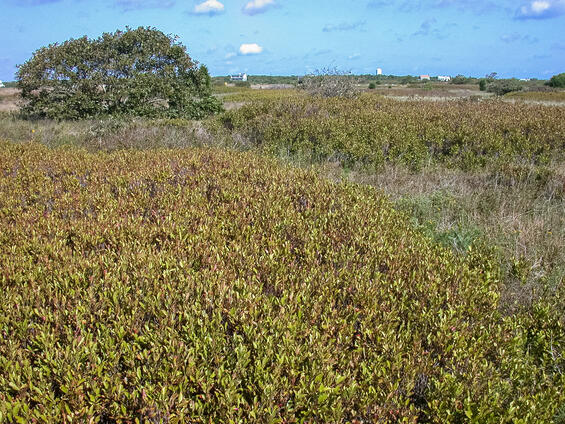- Scientific name: Cingilia catenaria
- Species of Greatest Conservation Need (MA State Wildlife Action Plan)
- Special Concern (MA Endangered Species Act)
Description

Chain dot geometer, Cingilia catenaria
The chain dot geometer (Cingilia catenaria) is a geometrid moth with a wingspan of 30-40 mm (1.2-1.6 in) (Forbes 1948). Both the forewing and the hind wing are white with postmedial and terminal “chains” (lines) of black dots. The forewing also has an antemedial line of black dots, and a reniform spot consisting of a small black dot. The discal spot on the hind wing is a similar black dot. There are bright yellow patches on the head and the thorax at the base of the forewing; the body is otherwise white. The larva is a bright yellow inchworm with thin black stripes; the spiracles are black, surrounded by white patches flanked with black. It grows to a length of 35 mm (1.4 in) (Wagner 2005).
Life cycle and behavior

In Massachusetts, chain dot geometer moths fly in September and early October, with the peak flight in late September. Eggs overwinter and hatch in early summer. Larvae feed in July and August on a variety of shrubs, with an apparent preference for huckleberry (Gaylussacia), blueberry (Vaccinium), bayberry (Morella pensylvanica), and sweet gale (Myrica gale).
Distribution and abundance
The chain dot geometer is found from Nova Scotia and New Brunswick south to Maryland, and west to Ohio, Minnesota, and Alberta (Covell 1984, McGuffin 1987, Wagner 2005). Formerly more common and widely distributed in Massachusetts, this species is now restricted to locations near the coast in the southeastern part of the state.

Distribution in Massachusetts.
1999-2024
Based on records in the Natural Heritage Database.
Habitat
In Massachusetts, the chain dot geometer inhabits open coastal habitats on sandy soil, including dunes and bluffs, sandplain grasslands and heathlands, other maritime shrublands, and occasionally similar open areas in pitch pine-scrub oak barrens.
Healthy habitats are vital for supporting native wildlife and plants. Explore habitats and learn about conservation and restoration in Massachusetts.

Sandplain grassland with huckleberry (Gaylussacia) and other shrubs, habitat for the chain dot geometer. Habitat managed by Edgartown Conservation Commission at Katama Plains Nature Preserve and Airfield.
Threats
The chain dot geometer is threatened by habitat loss and fire suppression. Other potential threats include introduced generalist parasitoids, aerial insecticide spraying, non-target herbicide application, and off-road vehicles. This species is vulnerable to climate change; it is endemic to the northern Atlantic coastal plain and threatened by both warming temperatures and sea level rise.
Conservation
Land protection and habitat management are the primary conservation needs of the chain dot geometer in Massachusetts. In particular, coastal dunes and bluffs, sandplain grasslands and heathlands, and other maritime shrublands should be conserved, restored, and managed to maintain habitat for this species and other species dependent on such habitats.
Survey and monitoring
The distribution of the chain dot geometer in Massachusetts is well documented. Known populations of this species should be surveyed to document persistence at least once every 25 years; every 10 years is more desirable when practicable.
Management
Management of coastal dunes and bluffs should avoid dune nourishment (addition of sand) or other alteration of natural habitat substrate and structure. Management of sandplain grasslands and heathlands, and other maritime shrublands, benefits a suite of rare and threatened species, and habitat condition should be monitored and management adapted as needed.
Research needs
The natural history and conservation needs of the chain dot geometer are well documented. However, the habitats of this species are vulnerable to climate change; the future effects of a warming climate on this species should be studied.
References
Covell, C.V. 1984. A Field Guide to Moths of Eastern North America. Peterson Field Guide Series. Houghton Mifflin, Boston, Massachusetts. 496 pp.
Forbes, W.T.M. 1948. Lepidoptera of New York and Neighboring States. Part II. Memoir 274, Cornell University Agricultural Experiment Station, Ithaca, New York. 263 pp.
McGuffin, W.C. 1987. Guide to the Geometridae of Canada (Lepidoptera). Volume II. Subfamily Ennominae, part 4. Memoirs of the Entomological Society of Canada No. 138: 1-182.
Wagner, D.L. 2005. Caterpillars of Eastern North America. Princeton University Press, Princeton, New Jersey. 512 pp.
Contact
| Date published: | March 21, 2025 |
|---|